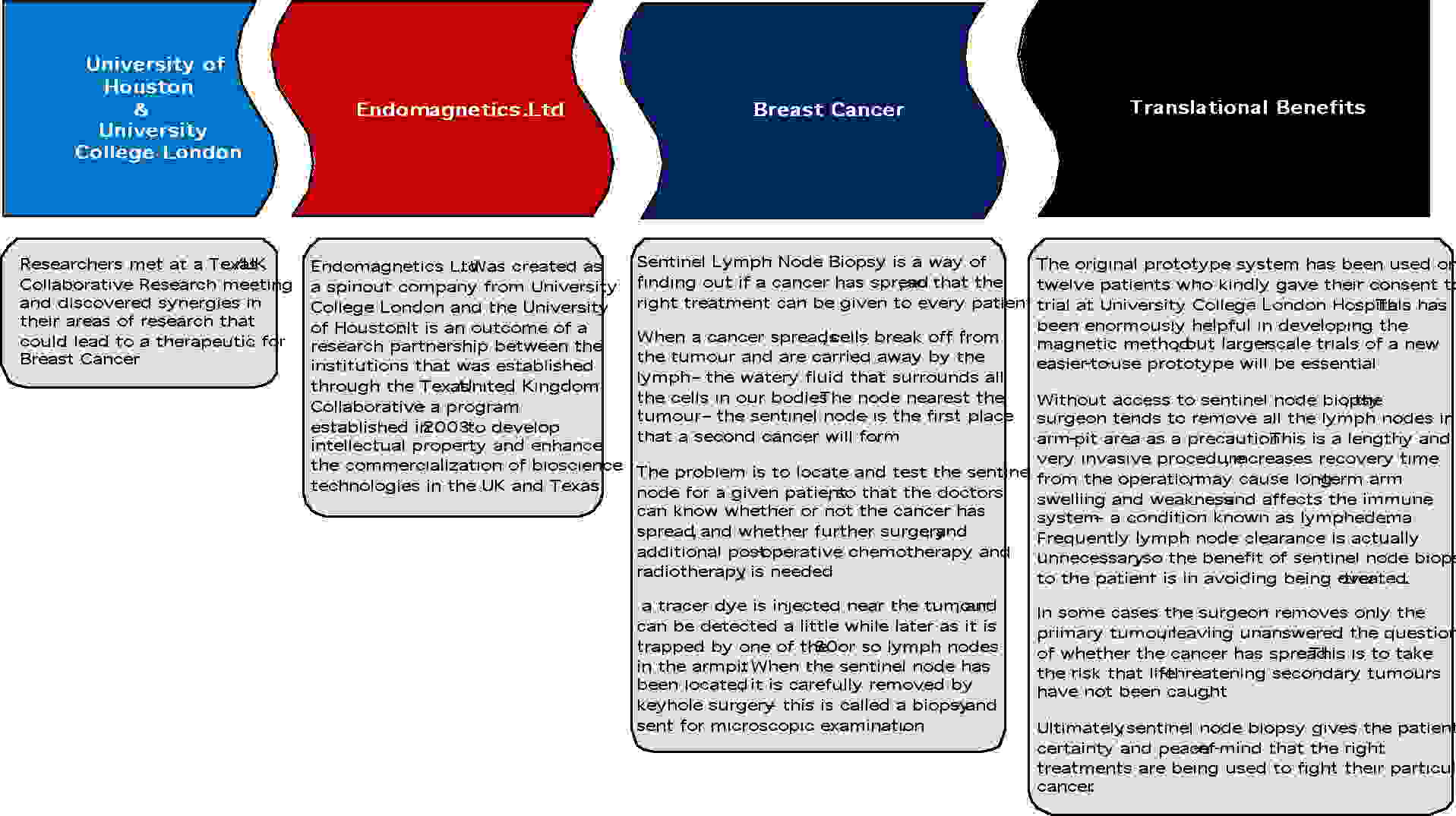| << Chapter < Page | Chapter >> Page > |
Phase I demonstrated that collaboration between member institutions could lead to significant benefits to academic partners and impact upon the regional knowledge economy. Examples of such outcomes include:
Building on an agreement, signed on December 15, 2004, between M. D. Anderson Cancer Research Center and Imperial College London, for the establishment of a research program focused on identifying new molecular targets for cancer diagnosis and treatments. Both MD Anderson and Imperial are internationally renowned for their commitment to and excellence in translational medicine, driving pioneering cancer research from the laboratory to patient therapies at the bedside. Both institutions invested in technology transfer and collaborative applied research initiatives in order to bring research discoveries to the market for the benefit of cancer patients. The strategy of the collaboration is to maximize their strengths in basic science research and clinical programs, accelerating the speed of scientific discoveries. Creating advantage for both MD Anderson and Imperial, were as M. D. Anderson could look for additional opportunities to identify promising new anticancer agents for clinical development and investigate new methods for diagnosing and treating cancer, and Imperial could expand its range of research programs and further contribute to the improvement of healthcare globally.
The Rector of Imperial at the time, Sir Richard Sykes, said, "Cancer research has long been a major focus at Imperial, and collaborations with such prestigious international partners as M. D. Anderson will help to further strengthen exploration of cancer treatments as a key part of Imperials research strategy."
The Proteomics Collaborative between the two institutions received $1M for its development and was significantly supported by the Texas/ UK Collaborative.
At the close of Phase I of the “Collaborative” there were research collaborations that lead to translational outcomes, two of which have significant results. Endomagnetics Ltd, a spin out company from the University of Houston and University College London, supported by the Collaborative, have completed a clinical trial detecting Sentinel Lymph nodes in 12 breast cancer patients ( [link] ). This technology allows for enhanced Sentinel node biopsy results in shorter breast cancer operations and better patient recovery, which saves money and frees up resources for healthcare providers like the NHS in the UK. There is also the opportunity to move the operations away from the largest cancer centres – the ones with access to radioactive tracers – to short-stay clinics and regional hospitals, which help to spread the load and to provide the services that patients need, locally.

Inclusive to this outcome there was the National Institute of Biomedical Imaging and Bioengineering (NIBIB) of the National Institutes of Health (NIH) established the Quantum Grants Program to make a profound (quantum) improvement in health care. This program challenged the research community to propose projects that have a highly focused, collaborative, and interdisciplinary approach targeted to solve a major medical problem or to resolve a highly prevalent technology-based medical challenge. The program consists of a 3-year exploratory phase to assess feasibility and identify best approaches, followed by a second phase of 5 to 7 years. To date, the NIBIB has awarded Quantum Grants to five interdisciplinary teams. The research collaboration between Baylor College of Medicine, Rice University, the National Institute of Medical Research in London, King's College of London, and Edinburgh University received NIBIB Awards First Quantum Grant of $2.9 Million over three-year on for Engineering Brain Microenvironments to Promote Stroke Recovery. A stroke occurs when compromised blood flow to the brain results in the death of neurons. Individuals who have had a stroke may experience partial paralysis or problems with awareness, attention, learning, judgment, memory or speech. Post-stroke rehabilitation can help stroke victims overcome some of these disabilities, but does not promote regeneration of the underlying damaged brain tissue. Injection of naked neural stem cells can stimulate some repair, but is generally inefficient.

Notification Switch
Would you like to follow the 'A study of how a region can lever participation in a global network to accelerate the development of a sustainable technology cluster' conversation and receive update notifications?